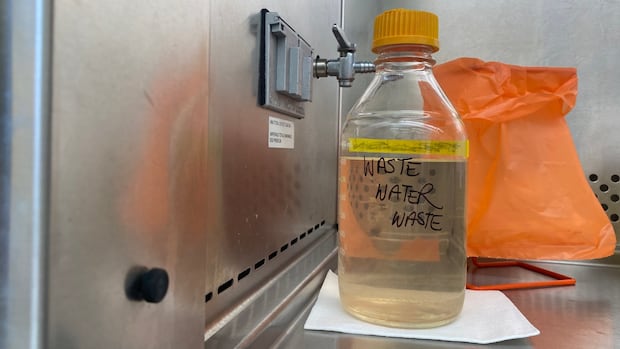Health Canada’s new front-of-package nutrition warning labels are beginning to appear on store shelves six months ahead of the food industry’s deadline.
First announced in 2022, the black-and-white labels alert shoppers if a product is high in sugar, sodium and/or saturated fat, which the federal department says can lead to increased health risks like stroke, obesity, heart disease, Type 2 diabetes, high blood pressure and some types of cancers.
“I think these can be a really great starting point for people that are looking to use labels as nutrition information sources. But I do think that there are some limitations,” said Brittany Brown, a dietitian based in Dartmouth, N.S.
“… Right now, it’s just going to be kind of functioning as a nutrition warning label, so it’s going to give consumers the information when things are high in sodium, high in saturated fat [and] high in sugar, but it’s not really going to tell them more details than that.”
Brown said flipping over the package will show details about percentages of daily value. She said the new label is automatically placed on foods that have 15 per cent or more of the daily value of sugar, saturated fat or sodium.
“If something only has 14 per cent of the daily value of sodium, it’s not going to trigger the nutrition warning, so that’s a bit of a missed opportunity.”
The intention behind the labels, according to Health Canada, is to help shoppers make “quick and informed choices” when buying food and support health professionals in educating people about food.
Brown said other countries have been using front-of-label packaging for years. For example, some European countries use Nutri-Score, which grades foods between A and E. “A” foods would be high nutritional quality while “E” would be lower nutritional quality.

Brown said while Health Canada’s labels can be useful, they don’t address certain complexities around food like cost.
“We know that food security is a really big challenge that people are faced with. So even if I am looking at the grocery store and I see that something is high in sugar, but my dollar only goes so far, I’m still going to have to choose that food item potentially,” Brown said.
For example, Brown said things like frozen entrees could end up with these labels, but for some that may be all an individual or family can afford.

“So I think that there is a bit of a risk with making us feel a little bit more judgy about some of the foods that we’re eating, and we really need to be careful about not putting that on to people.”
Liesel Carlsson, a professor of nutrition and dietetics at Acadia University in Wolfville, N.S., said she thinks shoppers may be surprised when the labels begin to appear on daily staples, like cereal, breads and some dairy products, but she could see that changing with time as companies adjust their recipes to no longer trigger the label.

“These labels don’t look good on packaging, so the real story here and part of the reason that industry was given a very long time in order to get their labels onto their packages is that many industry players will reformulate their products,” Carlsson said.
But what’s most interesting, she said, is that these labels are likely to result in more products that are inexpensive “that are still in this highly processed category but are less damaging to health.”
In terms of the labels themselves, Carlsson said there is evidence to show they’re effective.
“Even when consumers are not even seeking nutrition information, this type of front-of-pack label will catch people’s eyes,” she said, but added the look of Canada’s labels are “a little bit underwhelming,” especially when compared to some South American countries, which use large black stop signs to communicate a similar message.

Although the food industry has until Jan. 1, 2026, to put the front-of-package labels on the foods, some products already have it.
The Nova Scotia-based grocery chain Sobeys, for example, has the label on many of its store-brand products, like Compliments and Big 8.
These included items in the frozen food and snack aisle, like microwave popcorn, frozen chicken wings, burgers and pop.

“We are committed to meeting the Health Canada front of pack labelling requirements and to empowering customers with clear information that supports the choices they make in our stores every day,” Sobeys said in an email to CBC News.
“We have made good progress to make the labelling changes to our Own Brands assortment ahead of the deadline by working proactively with our supplier partners.”
The labels are mandatory for prepacked foods, but Health Canada notes there are some exemptions.

Certain dairy products such as plain milk, plain yogurt and cheese are exempt “because they are important sources of calcium that is needed to promote bone health and reduce the risk of osteoporosis.”
Health Canada said raw, single-ingredient ground meats and poultry are exempt “to avoid giving the impression they are nutritionally inferior to whole cuts that do not carry a nutrition label.”
Butter, sugar, salt and other products used for the same purpose are also exempt. Some products are also exempt for technical reasons, like foods in very small packages.






